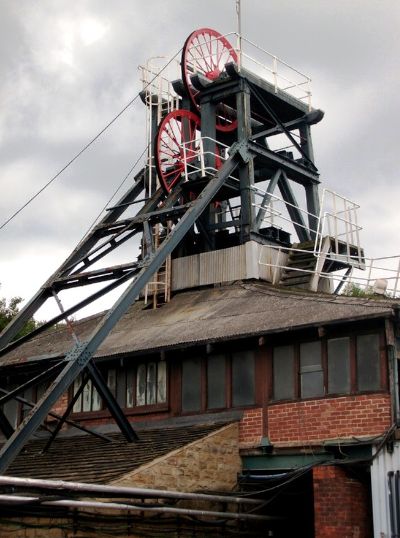
Caphouse Colliery
Copyright © L Hirst and used with his kind permission
Now the National Coal Mining Museum: England, the 11 foot diameter, brick-lined shaft at Caphouse was sunk around 1790 to work the Flockton Thick (1.22 m) and Thin (0.38 m) seams. The timber headgear is a rare survival, because they were classed as a fire hazard and were not built after the 1911 Mining Act. There was also a furnace pit, which has recently been restored, to provide ventilation.
At first the pit was leased to the owners of the nearby Flockton colliery, but by the 1850s Caphouse Pit was being worked as part of Denby Grange colliery by Sir J.L.L. Kaye. On his death, Miss Emma Lister-Kaye took over in 1871. Her initials can be seen on a date stone (ELK 1875) on the winding engine house. The twin-cylinder steam winding engine, by Davy Bros., is still in situ. It was bought from a woollen mill and was used regularly until 1974, and occasionally until 1981.
The mine was run by the executors of E. Lister-Kaye, from 1905 (when she died) until 1921 when it was taken over by Denby Grange Collieries Ltd.
| Chairman/MD | Percy Christian Greaves |
|---|---|
| Directors: | Henry Bower Tatton Cecil Lister Kaye Sir John Lister Kaye |
Greaves was also on the boards of: Airedale Collieries Ltd, Manor Haigh Moor Colliery Ltd, Terry, Greaves & Co. Ltd, Henry Briggs, Son & Co. Ltd and Robert Holliday & Sons Ltd which all ran collieries around Wakefield.
From 1943 to 1946, however, Lockwood & Elliott, the owners of Shuttle Eye colliery (3.3 km to west on A642) ran Caphouse. Then it was nationalised. Caphouse was a fairly small pit, with an average of 177 men working underground, and 46 on the surface for most of its time under the NCB. Output was restricted by its narrow (11 feet diameter) shaft which limited the winding capacity. In 1974, therefore, a conveyor drift was opened to bring coal to the surface.
| New Hards | 1903-1913 |
| Wheatley Lime | 1903-1962 |
| Beeston | 1941-1975, 1981-1985 |
| Top Beeston | 1976-1980 |
During 1980, Caphouse was merged with Denby Grange to form Caphouse-Denby Grange. Then, with its available coal nearing exhaustion, Caphouse was scheduled to close in late October 1985, but first, in September 1985, it was merged with Bullcliffe Wood and the new Calder Drift, and the whole renamed Denby Grange. Caphouse did close in October 1985, but the original Denby Grange (Prince of Wales Pit), at Netherton, worked until August 16th 1991.
| 1854-1875 | Sir J.L.L. Kaye, Bart |
| 1876-1904 | Miss E. Lister-Kaye |
| 1905-1921 | Exors of E. Lister-Kaye |
| 1922-1942 | Denby Grange Collieries Ltd |
| 1943-1946 | Lockwood & Elliott |
| 1947-1985 | National Coal Board |
| 1988-1994 | Yorkshire Mining Museum |
| 1995- | National Coal Mining Museum for England |
Caphouse was to have a new life, however, and in 1988 it reopened as the Yorkshire Mining Museum. Following the closure of Chatterley Whitfield colliery museum in 1991, Caphouse became the National Coal Mining Museum for England from 1995 onwards.
Hope Pit, at the eastern end of the museum site, was sunk between 1827 and 1829 under the supervision of John Blenkinsop, the mining engineer, who was based at Middleton Colliery in Leeds. It is now used to pump highly ochrous water, to prevent it surfacing in other places, and treat it. Another survival, in the same area, is the Cornish pumping engine house on Inman’s Shaft, which dates from around 1841. A large modern building, the Hope Store, houses some of the museum’s large mining machinery and vehicles. These include underground locomotives, BJD coal cutters, a 1967 NCB Morris ambulance used at Markham Main Colliery, South Yorkshire, and a seventeen-tonne Dosco Roadheader.
The National Museum is well worth a visit. You can either go underground or examine the surface remains and many displays. The library is an excellent centre for researching all aspects of coal mining. www.ncm.org.uk
If you are in Scotland or Wales, why not visit:
- Lady Victoria Colliery, Newtongrange, Midlothian, EH22 4QN – www.nationalminingmuseum.com
- Big Pit National Coal Museum, Blaenafon, Torfaen, NP4 9XP – www.museumwales.ac.uk/bigpit

